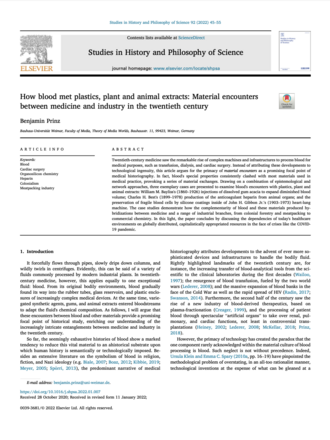How blood met plastics, plant and animal extracts
Benjamin Prinz's latest article published in Studies in History and Philosophy of Science
Twentieth-century medicine saw the remarkable rise of complex machines and infrastructures to process blood for medical purposes, such as transfusion, dialysis, and cardiac surgery. Instead of attributing these developments to technological ingenuity, this article argues for the primacy of material encounters as a promising focal point of medical historiography.
In fact, blood's special properties consistently clashed with most materials used in medical practice, provoking a series of material exchanges. Drawing on a combination of epistemological and network approaches, three exemplary cases are presented to examine blood's encounters with plastics, plant and animal extracts: William M. Bayliss's (1860–1926) injections of dissolved gum acacia to expand diminished blood volume; Charles H. Best's (1899–1978) production of the anticoagulant heparin from animal organs; and the preservation of fragile blood cells by silicone coatings inside of John H. Gibbon Jr.‘s (1903–1973) heart-lung machine.
The case studies demonstrate how the complementarity of blood and these materials produced hybridizations between medicine and a range of industrial branches, from colonial forestry and meatpacking to commercial chemistry. In this light, the paper concludes by discussing the dependencies of today's healthcare environments on globally distributed, capitalistically appropriated resources in the face of crises like the COVID-19 pandemic.
Benjamin Prinz works as a research assistant at the chair for Theory of medial Worlds and since 2020 has been involved in the DFG project "Media and Organs. Configurations of the Body in Posthumanism". His dissertation project focuses on John H. Gibbon's experimental surgical attempts to develop the heart-lung machine (1930-1953).
Link to the article: https://doi.org/10.1016/j.shpsa.2022.01.007

